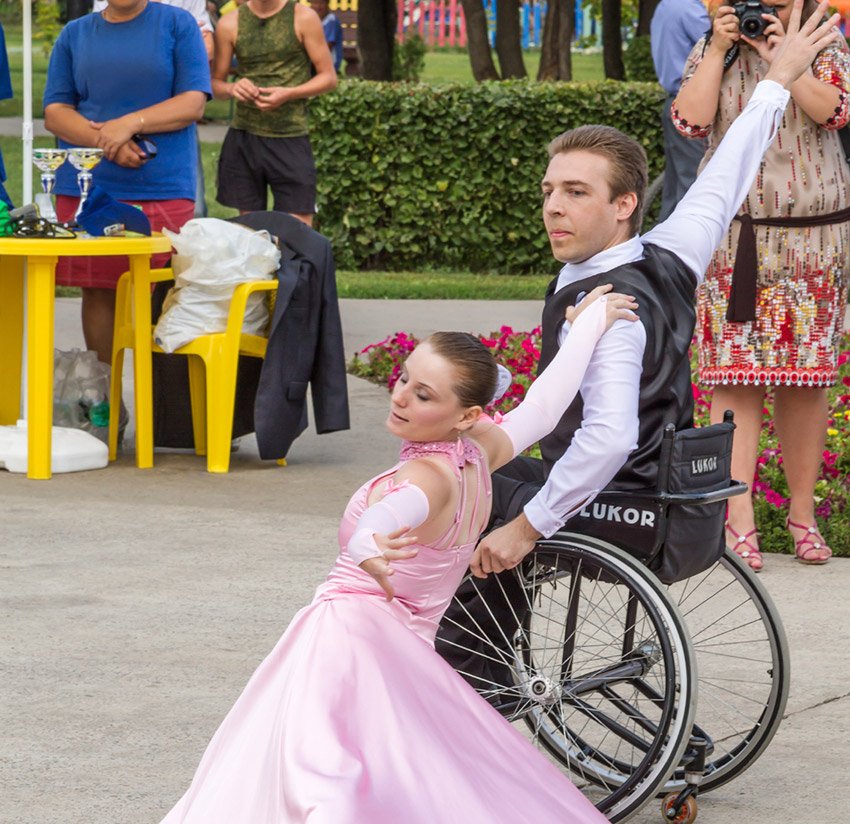A dancer with a physical disability is just like any other dancer, especially in the beginning stages. They might feel self-conscious, worry that they can’t “get” the moves or will never be good enough, and may struggle with fear and anxiety when getting out on that dance floor. Yes, salsa (like any type of formal dance) evolved with the assumptions that dancers were fully abled bodied—but anyone who’s seen a dancer who seems to have “two left feet” knows that not all bodies are created equally. Some people naturally pick up salsa like they’ve been dancing for years, others struggle for a long time until they find the right teacher or environment, and most fall squarely in the middle with a slew of natural strengths and weaknesses based on their body’s abilities, their past experiences, and their determination. Dancers with disabilities are no different.
Yes, modifications may need to be made. For example, if a male dancer is in a wheelchair, the follower may need to dip a little lower for spins or the pair can decide upon a lead’s cue that doesn’t involve maintaining palm to palm contact. A dancer in a wheelchair may prefer to exhibit more flash and flair with their upper body rather than depending heavily on fancy footwork. However, any dancer isn’t sure of what works best for them and what’s most comfortable until they practice and experiment.
In the Classroom
If a dancer with a disability is interested in taking a class, they may prefer to meet with the instructor in advance and give them a heads up about their expectations and goals. This certainly isn’t a requirement, but it can help the instructor (who may not have worked with a client with a disability before) best plan how to incorporate these needs into the lesson. Of course, a good studio welcomes all levels and abilities and you’re certainly not required to contact the instructor in advance.
One of the reasons most classes require students to dance with every available partner is because that’s the best way to better your own practice. The more people you dance with, the more diverse their style and abilities, the better you’ll both become. This goes for dancers with disabilities, too. The vast majority of people in a classroom setting (and Latin clubs!) are there to meet fellow salsa lovers, become better dancers, and practice with as many different partners as possible. Dancers with disabilities bring something rare and much needed to the salsa world. That’s why there are entire festivals, dances and congresses dedicated solely to dancers with disabilities!
When Your Go-To Partner Has a Disability
If you’re dating someone with a disability and want to take salsa classes together, chances are you’ve been together long enough to have some understanding of how they prefer to have the disability addressed. Independence is key for everyone, and they probably already have some ideas of how they’d like the classes to pan out. Let them take the lead with this (even if they’ll be a follower on the dance floor!). They’ll tell you what they need, like and want as a dance partner, just like you’ll do the same. It’s up to them to inform the instructor of any requests, and “helping” is strongly discouraged unless your partner directly ask for it.
However, one potential issue, in both studios and clubs, may be accessibility. If a dancer requires (for example) a ramp or elevator, those might not be readily available. Many cities and towns are getting better at disability accessibility, but are far from perfect. However, if you have a particular interest in a studio or club, talk to the manager or owner. They are likely not educated or aware of the problem, and it’s in their best interest to address it. A temporary solution may be available, or if they’re particularly committed to tolerance they might even prioritize making the space accessible to all. You never know until you ask.
In the Clubs
Going to a local salsa club can be a little more intimidating, especially if you go without a regular partner. However, know that everyone 1) gets rejected time to time when asking someone to dance or 2) turns someone down. You’ll probably never know the reason why, and it doesn’t matter. Practicing in a club setting is a great complement to class lessons, and a fantastic way to meet those who share your passion. You’ll find that many club goers are very gracious and happy to dance with partners of all abilities. If you ask someone and they seem wary, you might want to reassure them that you’ll be able to dance together with ease (just know that you may need to talk them through some modifications). The desire for variety in dance is why you see clearly professional dancers leading a first-timer around the floor. It’s why retiree women are being dipped by barely legal dancers. Six-foot tall women dance with men who hover at just over five feet. When there’s a mutual love of dance, you make it work and everyone becomes a better dancer for it.
Are there challenges for dancers with a disability, physical or otherwise? Of course! However, those obstacles might not be any more or less trying than someone who feels like they have no sense of rhythm or are painfully shy. The only way to triumph is to get out there and go for it. Remember that you set your own parameters, bringing instructors into a conversation only if it suits you.
Additional resource:
For more information on dancing with a disability, check out the American DanceWheels Foundation for special instructor certification, educational programs and Skype lessons.


Leave A Reply